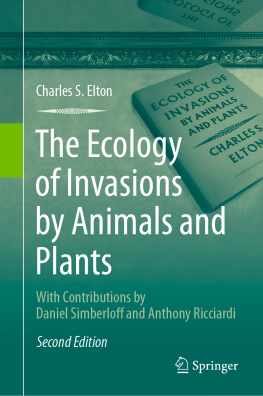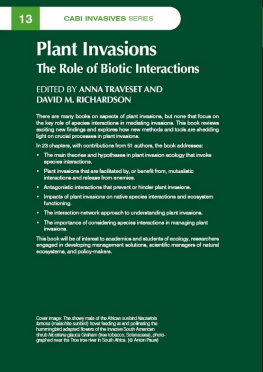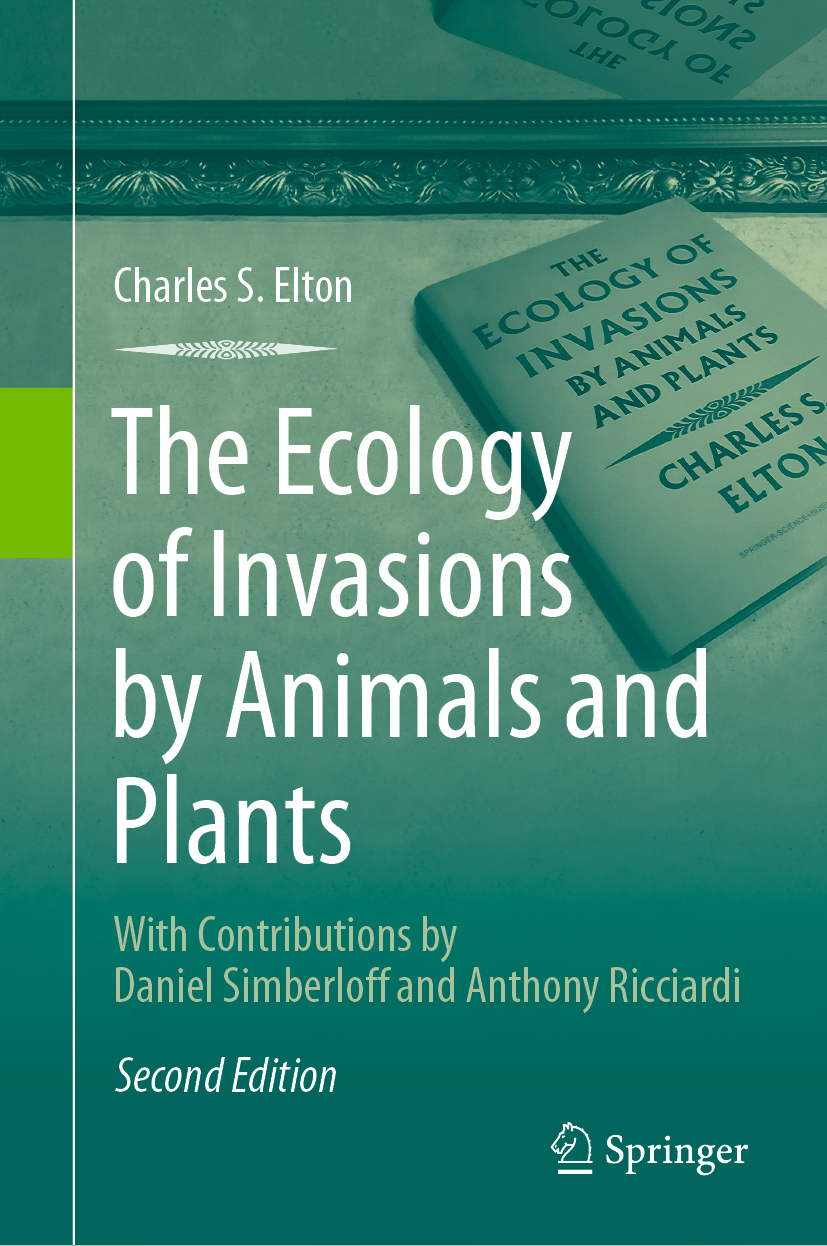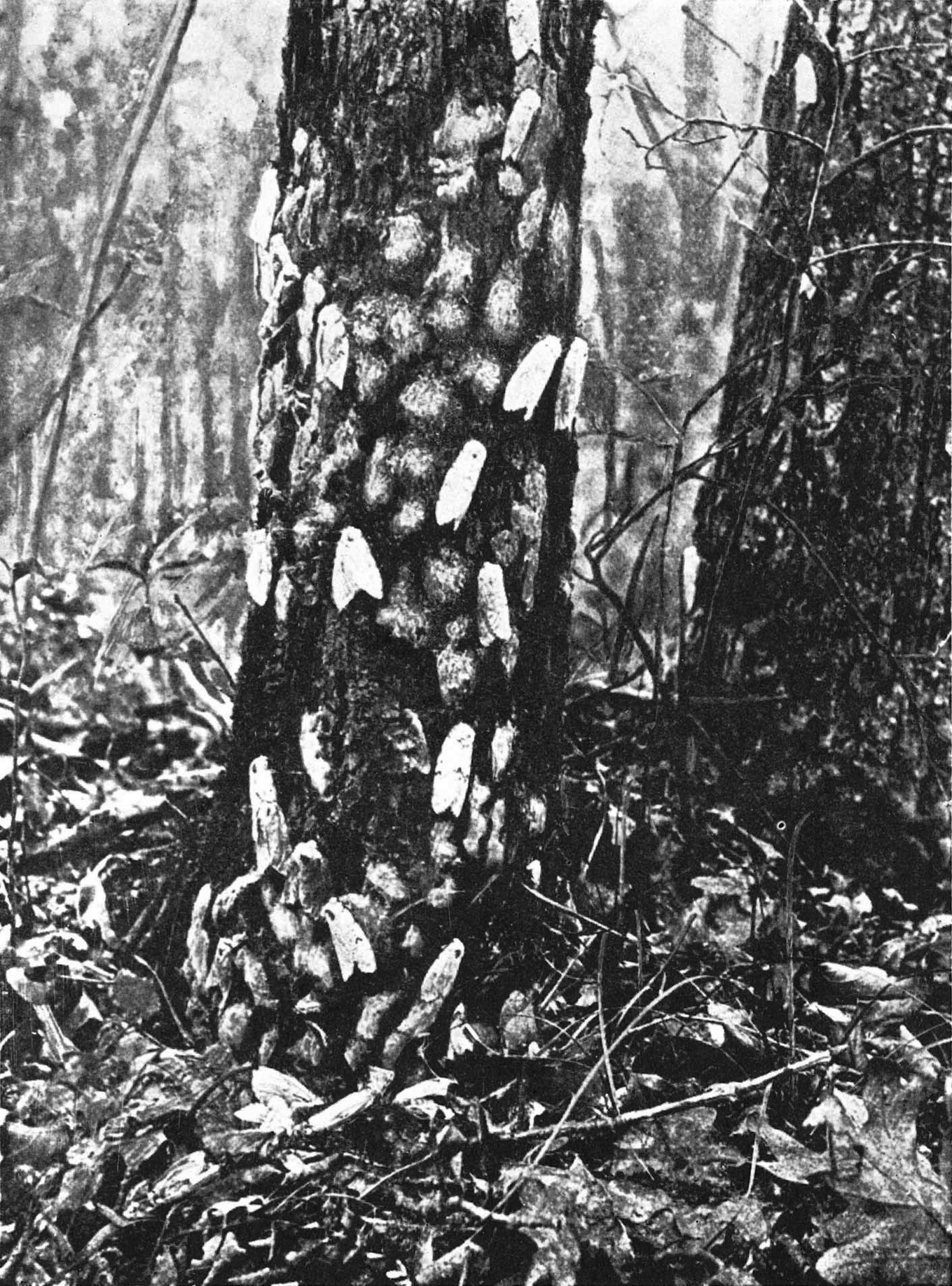Charles S. Elton
The Ecology of Invasions by Animals and Plants
2nd ed. 2020
With contributions by Daniel Simberloff and Anthony Ricciardi
Charles S. Elton
University of Oxford, Oxford, UK
ISBN 978-3-030-34720-8 e-ISBN 978-3-030-34721-5
https://doi.org/10.1007/978-3-030-34721-5
Springer Nature Switzerland AG 2020
This work is subject to copyright. All rights are reserved by the Publisher, whether the whole or part of the material is concerned, specifically the rights of translation, reprinting, reuse of illustrations, recitation, broadcasting, reproduction on microfilms or in any other physical way, and transmission or information storage and retrieval, electronic adaptation, computer software, or by similar or dissimilar methodology now known or hereafter developed.
The use of general descriptive names, registered names, trademarks, service marks, etc. in this publication does not imply, even in the absence of a specific statement, that such names are exempt from the relevant protective laws and regulations and therefore free for general use.
The publisher, the authors and the editors are safe to assume that the advice and information in this book are believed to be true and accurate at the date of publication. Neither the publisher nor the authors or the editors give a warranty, expressed or implied, with respect to the material contained herein or for any errors or omissions that may have been made. The publisher remains neutral with regard to jurisdictional claims in published maps and institutional affiliations.
This Springer imprint is published by the registered company Springer Nature Switzerland AG
The registered company address is: Gewerbestrasse 11, 6330 Cham, Switzerland
Frontispiece.Female gipsy moths,Lymantria dispar,depositing their egg-clusters on the trunk of an oak-tree in Massachusetts, 1895. (From E. H. Forbush and C. H. Fernald, 1896.)
TO MY WIFE
E. J. SCOVELL
Preface
In this book I have tried to bring together ideas from three different streams of thought with which I have been closely concerned during the last thirty years or so. The first is faunal history, usually regarded as a purely academic subject, but to some of whose events can be traced a number of the serious dislocations taking place in the world today. The second is ecology, particularly the structure and dynamics of populations. The third is conservation. I first published a few ideas about the significance of invasions in 1943, in a war-time review calledPolish Science and Learning, under the title of The changing realms of animal life. Since then I have had the opportunity to think pretty hard about conservation, while taking part in the planning and development of the Nature Conservancy. In March 1957 I gave three broadcasts in the B.B.C.s Third Programme, under the title of Balance and Barrier. These were subsequently printed inThe Listener(1957, Vol. 57, pp. 514-15, 556-7, 596-7, and 600). The present book is essentially an expansion of these. I am extremely grateful to Mr James C. Thornton and Dr John Simons for advice and help in planning and giving these talks.
In preparing this book I have had invaluable assistance from the staff of the Bureau of Animal Population. Miss C. M. Gibbs typed the fair copy. Miss M. Nicholls has given me much advice on bibliographical matters. And Mr Denys Kempson has employed his superlative skill at photography in copying and printing the 101 illustrations. Without his help particularly I could not have made the book in its present form.
For permission to reproduce illustrations I am very grateful to a number of people and institutions, who are individually acknowledged in the legends under them. I want to thank Mrs M. J. Thornton and Mr J. S. Watson very much for allowing me the use of original photographs. The following have given invaluable help in getting me the use of other unpublished photographs: Dr Paul DeBach, Citrus Experiment Station, University of California; Mr F. H. Jacob, Plant Pathology Laboratory, Ministry of Agriculture, Fisheries and Food; Dr R. F. Morris, Forest Biology Laboratory, Science Service, Canadian Department of Agriculture; Miss P. Sichel, National Maritime Museum, Greenwich; Dr Edward Graham and Dr William Van Dersal, U.S. Soil Conservation Service.
I am obliged to Dr W. E. Swinton, British Museum (Natural History), for some information about dinosaurs, and to Dr Erling Christophersen for information about plant species on Tristan da Cunha.
I have found useful references in a paper by Marston Bates (1956), Man as an agent in the spread of organisms (inMans role in changing the face of the earth,ed. by W. L. Thomas and others, Chicago, pp. 788804). This is the only recent general review of the subject of invasions that I have seen.
The life-group pictures in Chap., borrowed from Alfred Russel Wallaces great bookThe Geographical Distribution of Animals, are included not only for their own merit, but because I discovered that only two members of a large class of advanced zoology students had ever read the book. I have kept his Latin names without any attempt to bring them up to date, but have only used the genera and not the species.
I am grateful to my wife for reading the whole of this book before publication and for making most valuable suggestions.
Bureau of Animal Population,
Department of Zoological Field Studies,
Botanic Garden, Oxford.
24 July 1957
New Introduction
Charles Elton (19001991) is widely regarded as the father of animal ecology, which he defined as scientific natural history concerned with the sociology and economics of animals.[VI]He did not invent the discipline, but he was the pre-eminent leader of its development and he elucidated fundamental concepts such as the ecological niche, the pyramid of numbers, population cycles, and food chains. He viewed animal communities and their component populations as highly dynamic entities, and for most of his early career before the end of the Second World War he devoted his attention to the nature of population cycles, explosions, and crashes.
Elton earned his B.A. with first-class honours in zoology at Oxford in 1922 but never obtained a doctorate. He held teaching positions at Oxford starting in 1923, eventually being appointed Reader in Animal Ecology in 1936. He founded the British Ecological SocietysJournal of Animal Ecologyin 1932 and was its Editor for 19 years. In the same year, he established the Bureau of Animal Population to promote research on changes in animal numbers. During the Second World War, the Bureau was devoted to practical problems of controlling rodent pests that threatened the U.K.s food supplies. It became an internationally recognized research institute and an important training ground for young ecologists.
Before the Second World War, Elton began lecturing to the Zoology Advanced Class at Oxford on the subject of Faunal History. These lectures introduced a theme with which Elton would become forever associated: the effect of humans on global biogeography through the introduction, accidental or deliberate, of species across natural dispersal barriersa process that he described as the breakdown of Wallaces Realms.[XVIII]He brought the subject to public attention in 1957 when he narrated a BBC radio series titled Balance and Barrier.[XV]Using invasions as a focal issue, he described general principles of ecology in three broadcasts titled, respectively, When Nature Explodes, The Balance Between Populations, and the Conservation of Variety. These broadcasts were subsequently expanded in a book aimed at a lay audience and written, he said, in ordinary language that nevertheless would not sacrifice scientific integrity.[XVI]He completed
















